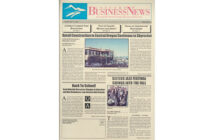Industry Expert Shares Tourism Trend Insights at COVA Conference
Value in vogue is the new watchword for leisure travel as consumers emerge with fundamentally altered behavior patterns in the wake of the worst recession since World War II, says an industry guru who gave the keynote address to Central Oregon Visitors’ Association’s 40th Anniversary Luncheon.
Increased demand for family and multi-generation trips focusing on alternate accommodations such as condos and homes would also likely play to the High Desert’s strengths as an outdoor playground paradise, according to nationally-renowned travel trend expert Peter Yesawich.
Yesawich, whose marketing and communications firm Ypartnership is regarded as one of the most respected sources of insights into future travel habits, preferences and intentions of Americans, told a well-attended conference at Bend’s Riverhouse Center; “It has been a challenging couple of years in the tourism industry, mirroring national trends, and when we come out of this we will land in a different place.
“As we suffered through the recession, there has been a significant impact on travel behavior and tourists have developed a different matrix.
“This new era of frugality means ‘cheaper is chic’ or ‘value in vogue’ are the new mantras, with increasing demand for menu pricing where rate trumps brand.”
Internet shopping as a vehicle enabling comparison shopping of fares and rates across multiple suppliers has also boosted consumers’ bargain-hunting power.
As a sought-after media commentator, Yesawich is well-placed to comment on the active travel psyche and his firm co-authors in-depth surveys such as ‘Portrait of American Travelers’ and ‘travelhorizons.’
Encouragingly, research pointed to a six percent increase in adults in the active traveler category (covering around 55 percent of the national population) saying they planned at least one leisure trip between May and October 2011.
While lifestyles are increasingly being consumed by work, demand for leisure travel remains strong as a break from job pressures.
But “potential inhibitors” to that direction include the price of gasoline, air travel and further fluctuations in the economy.
The strongest likely headwind remains the cost of gas, with many reporting that further price spikes will affect travel plans, including dictating that trips be within a shorter driving distance.
This would increase the significance of cultivating demand “closer to home” and for Central Oregon possibly point to renewed efforts to appeal to travelers within the critical four-hour drive time radius.
TRAVELER SENTIMENT
Yesawich pointed to a jump in traveler sentiment index in recent history, buoyed by discounted prices, but any macro move to increase rates in the face of such demand faced pressure from the “value travel” priorities of the customer.
He said, “The consumer is increasingly taking control; has done a good job of being more fiscally responsible in terms of the household balance sheet after economic tough times and is focused on finding the best deal.
“More people are going online for comparison shopping or waiting for target items to go on sale, are less likely to pay with credit cards and seek ‘menu pricing’ defining value according to price, quality and quantity in the new frugal reality.”
“Flash selling” is also on the upswing as a technique to tap the market, with broadcast emails touting, for example, 72-hour sales or specials giving five nights’ accommodation for the price of four.
One out of five travelers now buy a product as a result of receiving an unexpected email, and the number who took a “last minute” trip in the last year rose to almost 30 percent.
Increasingly, people experience “time poverty” and 40 percent reported feeling like they don’t have enough time.
Email has increased the average work day by an hour, and in a new culture of impatience the travel industry is marketing “against a share of the clock”.
Almost half of all vacationing now falls in the category of weekend, or long weekend trips of around four days, requiring different marketing strategies for Thursday through Sunday, as opposed to the balance of the week.
Yesawich said, “As vacation habits become compressed, speedy ‘hurry up and relax’ trips are on the rise.
“It’s all about convenience of access to the destination. The pace of life is quickening and some markets of greatest opportunity lie within that four-hour
travel radius.”
Time and budgetary pressures have also impacted business travel, with companies shaving costs by facilitating online video conferencing or cutting the number of days devoted to off-site meetings or conventions.
As life pressures escalate, with stress levels at historic peaks and spare time at a premium, people increasingly say they want to spend more time with friends and family.
Such renewed interest means vacations are less about rest and relaxation and more about reuniting with family, often across multiple generations with grandparents coming along or paying for the family trip.
The cruise industry was an early adaptor in this area, and has long offered third, fourth or even fifth cabin
discount rates
Of increasing relevance are “life event” or milestone celebration trips, often marking birthday or anniversary dates divisible by five – meaning some of the most critical data mined by marketing companies being birth or marriage dates.
CENTRAL OREGON OPTIONS
Often, alternative accommodations such as condos or houses are more popular vehicles for these vacations, which places Central Oregon and its plethora of options at the forefront of this trend. Internet access is also increasingly important for trips of all types.
Internet usage in regards to travel planning continues to expand, with a number of meta search engines – which search hundreds of travels sites at once – utilized in a quest to identify the best rates. Online outlets offering such service are on the rise, including sites like kayak.com, fly.com, momondo.com, sniqueaway.com and yapta.com.
And while a social media presence was important to access “eyeballs” it was still often trumped by family and friend recommendations, magazines, TV and professional travel guidebooks as sources of reliable information. Another interesting development is the rise of interest in engaging YouTube-style “video logs” describing various destinations.
In the new austere climate, Yesawich said, “There is evidently going to be even more competition and the consumer is increasingly smart and savvy regarding the market and where concessions can be found – whether that be in terms of discounts or premiums such as free breakfast or free additional nights.
“Transparency in pricing is key, and price and value will determine whether Central Oregon gets its fair share of travel and tourism spending.”
In introducing Yesawitch, COVA President and CEO Alana Audette hailed him as “the foremost expert in his field”, adding, “the relevance of travel and tourism on Central Oregon’s economic health and future economic vitality cannot be understated.”
In celebrating COVA’s 40th anniversary, Audette recollected the organization’s original incorporation as Central Oregon recreation Association (CORA) in 1971 by a band of progressive thinkers pushing a “rising tide” philosophy on the premise of the effectiveness of pooling resources in a collaborative marketing effort.
The group started with a budget of $25,000 which funded a modest ad campaign in Sunset magazine. Today COVA fields around half a million inquiries annually and manages a yearly budget of approximately $1.9 million.
Audette also paid tribute to long-time board member and Redmond Airport manager Carrie Novik, and Economic Development for Central Oregon (EDCO) leaders for their work as part of the task force maintaining and growing the critical component of air service in the region. She also hailed two community stalwarts who have been involved in the association since 1972 – Bill Smith and Mike Hollern.
The luncheon conference was also used as a platform to unveil a video previewing COVA’s new 2012 “Discovery” marketing campaign, in a high quality initiative developed by Bend’s DVA Advertising & Public Relations, capturing the essence of Central Oregon in a way appealing particularly to families.
Audette said of the broadcast element that COVA wanted a New York and Los Angeles quality “on a Central Oregon budget” and DVA had come through with flying colors.
COVA is the destination marketing association charged with the advertising and public relations support to position Central Oregon as both a fly and drive destination for leisure, business and convention travel. Supported by nearly 500 member businesses and operating with an annual budget of around $1.9 million; COVA manages tourism advertising, marketing, promotion, public relations, industry relations, special event management and a regional housing bureau for large scale conventions. COVA also operates the Central Oregon Welcome Center based in Bend.
541-389-8799 or www.visitcentraloregon.com.




